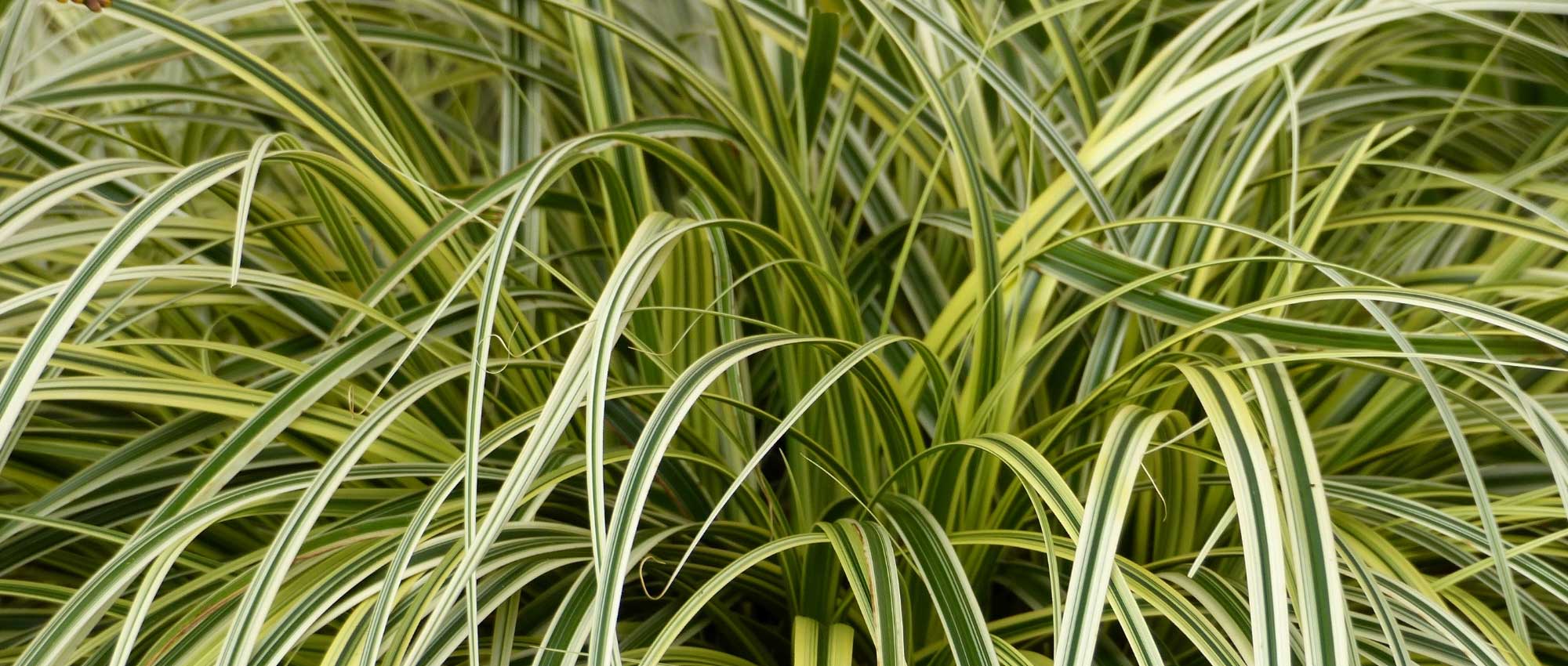
Carex: planting, dividing and care
Contents
Carex in a nutshell
- Carex offer evergreen and fine foliage that is essential in winter to dress the garden
- They come in a wide range of colours: yellow, blue, green, bronze, almost red…
- They immediately bring graphic appeal and lightness to the edges of borders and pots
- Carex are suited to shaded locations and most tolerate dry conditions very well
- Requiring almost no maintenance, they are very easy to grow grasses, robust and nearly indestructible!
- They adapt well to planting in pots, at the edge, or some grow very well on the banks of ponds
A word from our Expert
Carex are perennial grasses appreciated for their fine and colourful foliage. Depending on the varieties, the shades are very diverse: carex can be green, copper bronze, glaucous blue, yellow… and even variegated! The flowering of carex, in spikes, is quite discreet. We particularly appreciate the fine, orange foliage of Carex testacea, the often bright and variegated leaves of Carex oshimensis, the small tufts of fine leaves of Carex comans, or even Carex pendula, which forms tall, arching tufts… Among the thousands of species and varieties, you will have no trouble finding ones that you like!
Carex require almost no maintenance! They are very easy and hardy plants, which are not afraid of diseases or pests. They enjoy being placed in full sun or partial shade. Carex have the particularity of being adapted to rather moist soils, or at least cool ones. They thrive in ordinary ground that does not dry out too much in summer. They are multiplied by division of clumps in spring. Carex are generally quite hardy, but some species, particularly those from New Zealand, are sensitive when temperatures drop below –7 °C.
Carex integrate well into perennial borders, but can also be used as ground cover, at the edge, in pots or containers, and are also perfect for the banks of ponds.
Botany
Botanical data
- Latin name Carex sp.
- Family Cyperaceae
- Common name Carex, sedge
- Flowering summer, often between June and September
- Height generally between 20 and 60 cm, but sometimes over a metre!
- Exposure sun or partial shade
- Soil type ordinary, moist, not drying out in summer
- Hardiness often around -20 °C, but only -7 °C for New Zealand carex.
The carex, also known as sedge, is a herbaceous perennial plant resembling a grass. It is appreciated for its decorative foliage, which can take on various shades. Carex forms a vast group, as it includes over 2,000 species! They have a wide distribution, with most coming from temperate or cold regions (sometimes in arctic areas). They are mainly found in wet grounds, saturated with water: marshy soils, riverbanks, ponds, damp woodlands, heaths… In nature alone in France, there are already about 120 species, some of which can be found in gardens: Carex elata, Carex pendula, Carex flacca, Carex atrata… Since they mainly come from regions with cold or temperate climates, most carex have very good hardiness. However, some species from New Zealand are much less hardy than others.
Botanically speaking, carex is not a grass but a Cyperaceae, belonging to the same family as Papyrus (Cyperus papyrus)! It is a very large family, comprising over 5,500 species, most of which are carex, but it also includes Scirpus and Eriophorum. The cyperaceae are monocotyledonous plants, quite close to bulrushes, and often have triangular stems. They resemble large grasses, like the true grasses. Many plants in this family thrive in wet soils: papyrus, cotton grasses, Scirpus…
Carex derives its name from the Greek kairô, meaning I cut, referring to the sharp edges of its leaf lamina, which bear small teeth. In French, carex is often called “laîche”, a name that comes from the Latin lisca, referring to reeds. In English, it is called sedge.
Carex are predominantly tufted plants, growing in clumps that expand over time, like Carex pendula or testacea. This makes them quite easy to propagate by division! Other Carex have rhizomes, sometimes quite short, which makes the plant suckering. They spread in width but rarely become invasive. The roots of carex particularly tolerate wet, even suffocating soils.
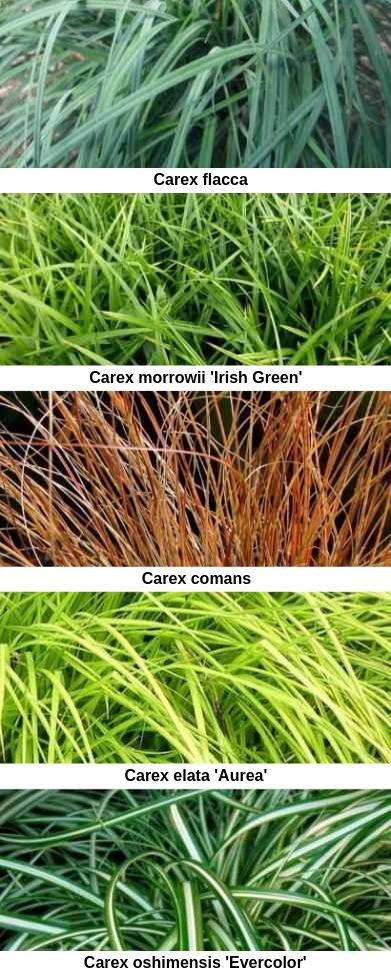
The foliage of carex can take on different shades!
Carex form fairly rounded and dense clumps, made up of numerous linear leaves. The fineness of the leaves gives carex a rather light appearance. Carex are generally small plants, not very tall. In most cases, they measure between 20 and 60 cm high. However, Carex firma barely exceeds 10 cm in height, while Carex pendula can reach 1.5 m! The use in the garden will therefore differ: small carex are well suited for border planting or in pots, even in rockeries for Carex firma… while the larger ones will find their place in beds, or even as solitary specimens for Carex pendula!
Carex often have a beautiful rounded and tufted shape. At other times, they are much more upright; but they can also be trailing or arching, as seen in Carex pendula.
The leaves of Carex have the advantage of being evergreen or semi-evergreen, generally remaining in place in winter, although some deciduous species can also be found. This is the case, for example, with Carex elata ‘Aurea’.
Carex offer exceptional diversity in terms of foliage shades! The range of colours is broader than in most grasses. The leaves can take on stunning reflections and nuances. Leaves can be very light, green-yellow, almost golden, as seen in Carex elata ‘Aurea’. At other times, they are bronze, almost reddish, as seen in Carex comans ‘Bronze Form’, Carex flagellifera or Carex buchananii. They can also be blue – glaucous (Carex flacca). The effect in the garden will be completely different! Bronze carex bring a warm touch, those with yellow or golden foliage are perfect for brightening a shady spot, while those with blue leaves create a harmonious and restful atmosphere. The Carex testacea ‘Prairie Fire’ has a stunning fiery hue with coppery reflections!
Some carex have variegated leaves! This is the case with Carex oshimensis ‘Everest’ or ‘Evergold’. They have a more original appearance than other varieties and bring a lot of brightness to the garden!
Carex can also offer changing shades, like Carex testacea, whose foliage evolves from light green to coppery orange, depending on the sun and the season.
The leaves are often long and thin, linear or thread-like, and closely resemble those of grasses! It is precisely their very fine foliage that gives them this light and graphic appearance! The leaves evoke hair that undulates with the wind, bringing movement to the garden! Sometimes, they are curled at the tips. The leaves can also be quite wide, as seen in Carex plantaginea, reminiscent of plantain leaves. In Carex ciliatomarginata ‘Shima Nishiki’, they resemble bamboo foliage!
As with grasses, the veins of Carex leaves are parallel. The midrib is strongly marked. The edge of the lamina bears small teeth, making it slightly sharp. The base of the leaves is sheathing, surrounding the stem.
The long leaves of carex are often beautifully pendulous, as seen in the variety ‘Feather Falls’. They can give the clump of carex a very wide and spreading appearance. When in pots or hanging baskets, trailing carex create a really interesting effect!
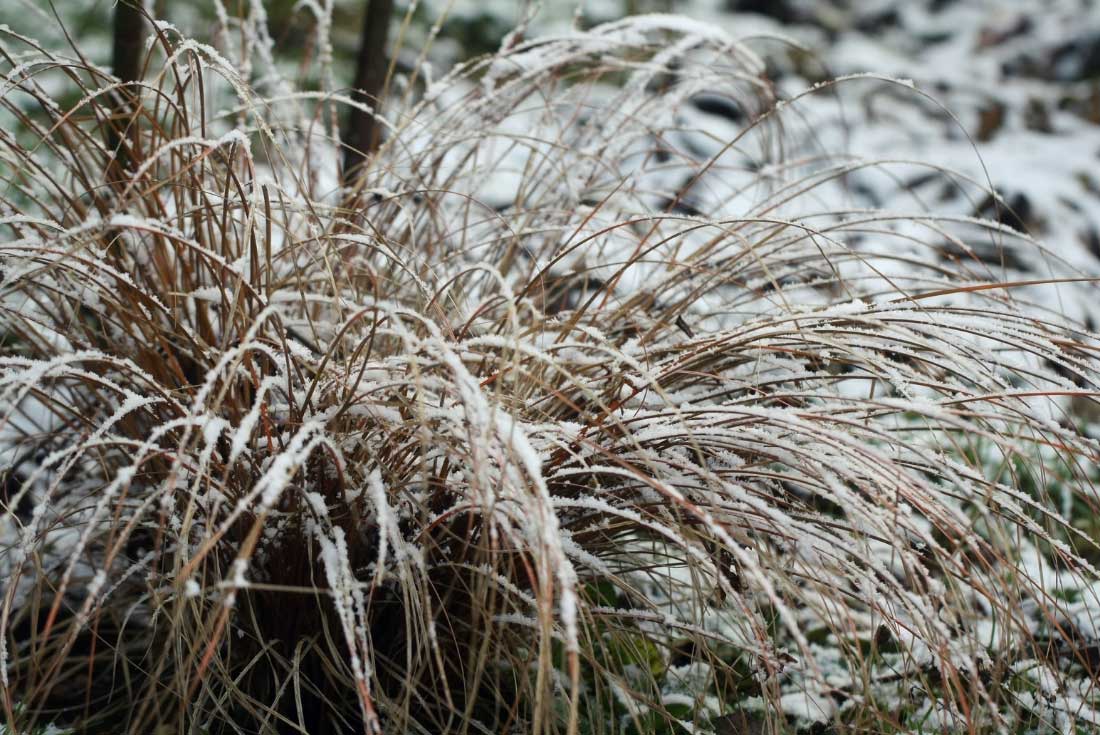
Many carex are evergreen and remain decorative in winter! Here, Carex buchananii
The stems of carex are not round, as in grasses, but have a triangular section. This is one of the characteristics of the botanical family of Cyperaceae!
The flowering of Carex generally occurs in summer, between June and September. However, some species flower in late spring.
Carex are mainly appreciated for their foliage: their flowering in spikes is somewhat reminiscent of that of grasses, but much more discreet, less exceptional. The spikes are nevertheless quite decorative in Carex pendula. They are long and drooping, somewhat resembling hazel catkins.
The flowers are very small and have no petals or sepals. They are gathered in thin and elongated spikes, which are themselves grouped at the tips of the stems. Each stem therefore bears several spikes, often with the lower ones entirely female (the flowers have pistils), while the upper spikes are entirely male (the flowers have stamens, releasing pollen). Most carex are monoecious, with male and female flowers on the same plant. The spikes are borne at the tips of upright, unbranched flowering stems.

Carex have a flowering consisting of male and female spikes. Carex elata (photo Hans Hillewaert), Carex atrata, Carex halleriana (photo Luis Nunes Alberto) and Carex pendula (photo Franz Xaver)
After flowering, carex produce achenes, often trigonal, which can be brown or green, or even yellow. They sometimes have a very pointed, elongated beak. It is advisable, especially with Carex pendula, to cut the spikes before fruiting to prevent the plant from spreading its seeds in the garden. The infructescences can be quite decorative and original, as seen in Carex grayi!
Read also
Pruning grassesThe main varieties of Carex
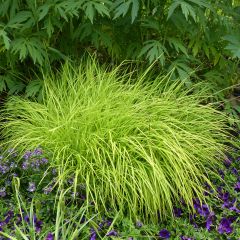
Carex elata Aurea
- Flowering time June to August
- Height at maturity 70 cm

Carex oshimensis Everest - Oshima sedge
- Flowering time October, November
- Height at maturity 25 cm

Carex oshimensis Evergold - Oshima Sedge
- Flowering time June, July
- Height at maturity 30 cm
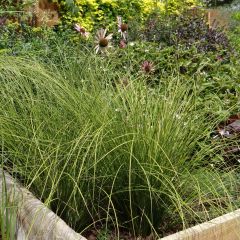
Carex testacea Lime Shine
- Flowering time August to October
- Height at maturity 50 cm
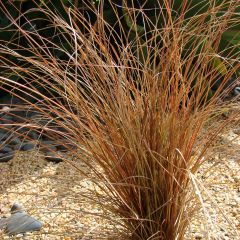
Carex comans Bronze Form
- Flowering time July, August
- Height at maturity 40 cm
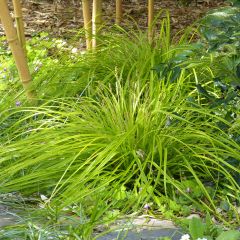
Carex oshimensis Everillo - Oshima Sedge
- Flowering time October, November
- Height at maturity 30 cm
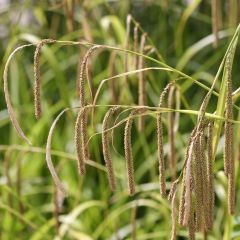
Carex pendula
- Flowering time July, August
- Height at maturity 1,20 m
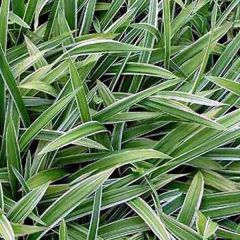
Carex siderosticta Variegata
- Flowering time May, June
- Height at maturity 40 cm
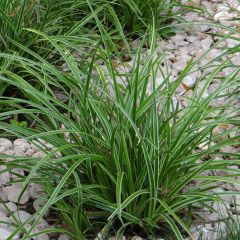
Carex morrowii Ice Dance
- Flowering time July, August
- Height at maturity 30 cm
Discover other Carex
View all →Available in 0 sizes
Available in 3 sizes
Available in 1 sizes
Available in 3 sizes
Available in 1 sizes
Available in 2 sizes
Available in 1 sizes
Available in 2 sizes
Available in 3 sizes
Available in 1 sizes
Planting Carex
Where to plant carex?
Carex thrive in sunny or partially shaded locations. Carex oshimensis is particularly suited to dry shade situations. In general, avoid scorching sun as well as overly dense shade.
Preferably plant them in soil that remains cool (not too dry in summer, not too wet in winter). Some species like Carex pendula and Carex riparia require moist soils and will do well at the edge of a pond. Carex can also help stabilise banks and have phyto-purifying properties.
Carex are quite suitable for planting in pots or containers. They form small, robust clumps that add volume and lightness to compositions alongside flowering plants.
You can use carex to create ground cover by planting them en masse. For example, choose a variety like Carex siderosticha ‘Variegata’.
If you live in a cold region and are growing less hardy carex, a good solution is to plant them in pots and bring them indoors for the winter.
Some carex, such as Carex firma and C. conica, can also find their place in rockeries.
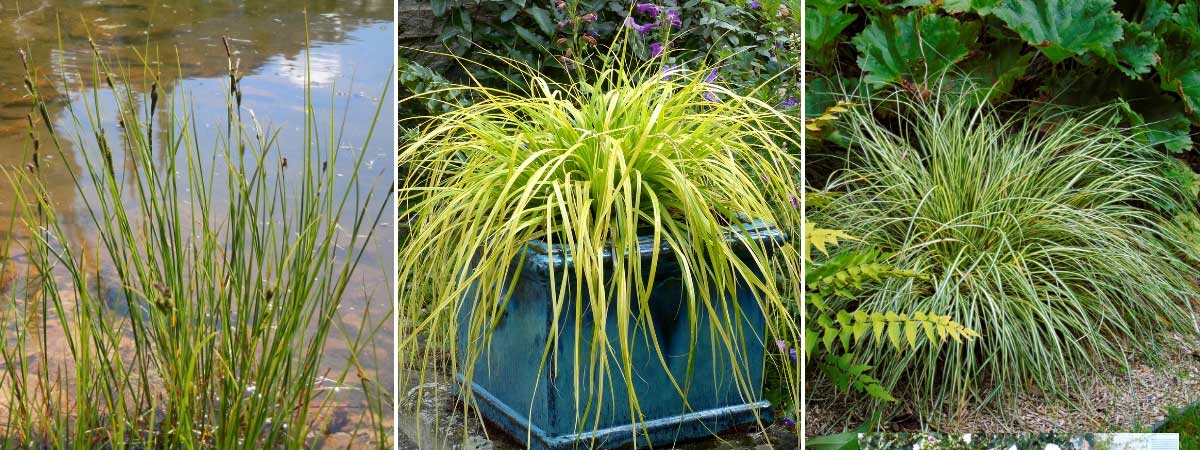 Carex can be installed on the banks of a pond (Carex aquatilis – photo Matt Lavin), in pots (Carex oshimensis ‘Everillo’), or in the ground in a border (Carex morrowii ‘Variegata’).
Carex can be installed on the banks of a pond (Carex aquatilis – photo Matt Lavin), in pots (Carex oshimensis ‘Everillo’), or in the ground in a border (Carex morrowii ‘Variegata’).
When to plant?
You can plant carex in autumn (September-October) or in spring (April-May). Wait until spring for the more tender species, such as those from New Zealand (Carex comans, C. testacea, C. buchananii).
How to plant?
The planting distance varies greatly depending on the species being cultivated (between 30 and 50 cm, depending on the size of the plant). You can install carex in large groups to achieve a ground-covering effect.
- Place the root ball in a basin filled with water.
- Dig a planting hole about twice the size of the root ball. If your soil is too draining and dry in summer, you can add some organic matter to help retain moisture.
- Remove the plant from its pot and place it in the planting hole, ensuring the top of the root ball is level with the soil surface. Fill in around it with soil.
- Water generously.
Continue watering in the months following planting. Be particularly vigilant during the first year, especially in summer, to prevent the carex from suffering from drought.
Care and pruning
Carex are easy plants that require almost no maintenance: they generally do not need watering, do not require fertiliser, and do not need pruning. Moreover, most varieties are quite hardy.
However, during summer droughts, it may be wise to carry out some watering to keep the soil relatively cool. Be more vigilant if you are growing them in pots or containers, as the substrate dries out more quickly. In open ground, do not hesitate to apply a mulch to maintain soil moisture.
You can cut the spikes when they are faded. It is preferable to prune those of Carex pendula before fruiting to prevent it from self-seeding.
It is sometimes advised for grasses to cut back clumps to the ground in winter. This is not the case for carex! You should leave the plants intact, without touching them. You may gently comb through the clumps in winter to remove dead leaves.
Be cautious with species native to New Zealand (Carex comans, C. testacea, C. buchananii), which are less hardy than others. If you are growing them in pots, consider bringing them indoors. Otherwise, place a thick layer of mulch around the stump to protect it.
We suggest dividing the clumps after a few years to rejuvenate them and give them more space.
Robust and easy, carex are rarely affected by diseases or pests! They may occasionally be attacked by aphids.
→ Learn more in our advice sheet: Diseases and pests of ornamental grasses.
How to propagate carex?
Like with grasses, the best technique for multiplying Carex is division, which is quicker and easier than sowing. They sometimes tend to self-seed spontaneously… You can thus take the young clumps that develop and place them in another location, but they may not be identical to the original variety.
Clump Division
It is quite easy to divide Carex when they are 4-5 years old! This allows for the regeneration of the clumps while providing them with more space. You can do this in spring, from April-May, and until July.
- Choose a clump that has been in place for several years.
- Gently dig it up. Remove any excess soil if necessary to expose the stump and roots.
- Divide it into three or four using a knife or spade.
- Replant immediately the clumps, either in pots or in the ground.
- Water generously.
Keep an eye on your young plants and water them regularly in the first few months to allow them time to develop their roots properly. If you have planted them in pots, you can place them in the ground the following spring.
Associating Carex in the garden
Enjoy the foliage of carex to play with colours! You can achieve a stunning effect by combining, for example, carex with bronze-copper leaves and orange flowers (wallflowers, Escholtzia, crocosmias, daylilies…)… Or by planting green-yellow carex alongside zingy blooms. It’s easy to create successful colour combinations by focusing on plants like Hakonechloa macra, persicarias, or Ophiopogon planiscapus ‘Nigrescens’. Also take advantage of heucheras, whose foliage comes in a beautiful range of colours! They will allow you to create a stunning scene in a dry shady spot.
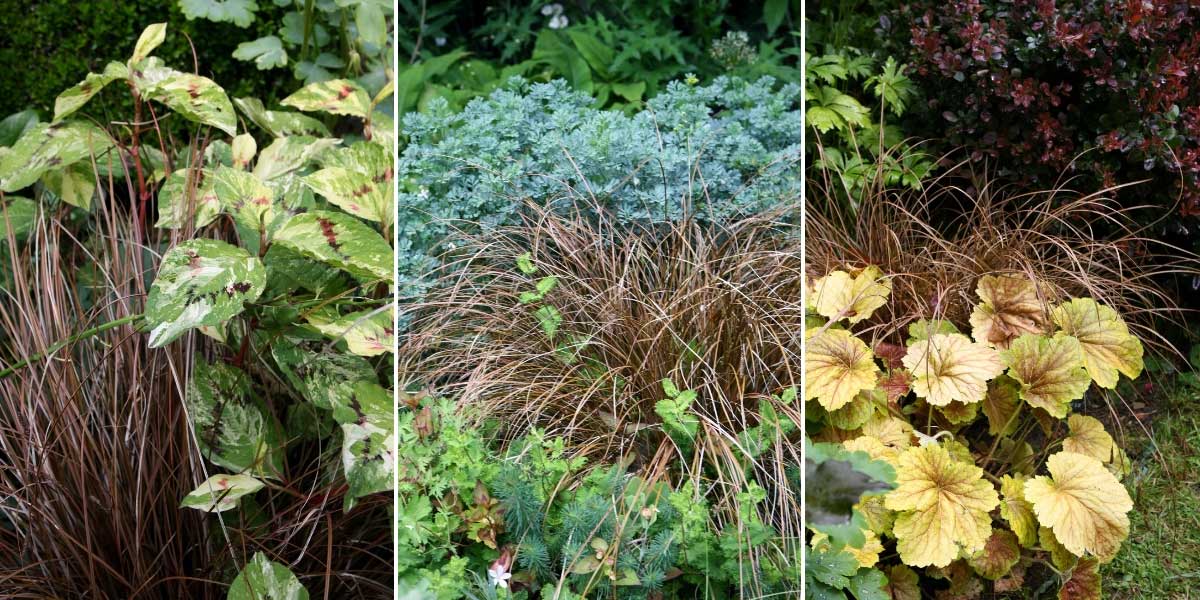
Carex buchananii pairs well with other decorative foliage, creating a scene with soft and warm tones. Carex buchananii and Persicaria virginiana ‘Painters Palette’ / Carex buchananii, Euphorbia ‘Fens Ruby’ and Ruta graveolens ‘Jackmans Blue’ / Carex buchananii, Heuchera and Berberis thunbergii. (Photos: Virginie Douce)
With their very fine and elongated foliage, carex are perfect for creating a very graphic scene. They bring a lot of lightness and volume to the garden! Plant them with other decorative foliage: that of ferns, grasses, Japanese maples, hostas, and ophiopogons… These combinations are ideal for an urban garden, for example in a courtyard, patio, or on a terrace. Add some blooms, such as those of Gaura lindheimeri, Verbena bonariensis, or Alliums.
Carex are an excellent solution for lightening a somewhat flat flowerbed made up of low, broad foliage. You can install them among bergenias, hostas, and heucheras. You will achieve a beautiful contrast of shapes!
For a very natural style garden, for example in a bright woodland, we recommend planting carex with luzulas, hostas, brunneras… Also enjoy the graphic foliage of ferns such as Cyrtomium fortunei, Polypodium vulgare, or Dryopteris… Add some Solomon’s seals and Tiarella, their delicate white blooms will brighten up the garden! You can also add some touches of colour with the elegant blooms of foxgloves!
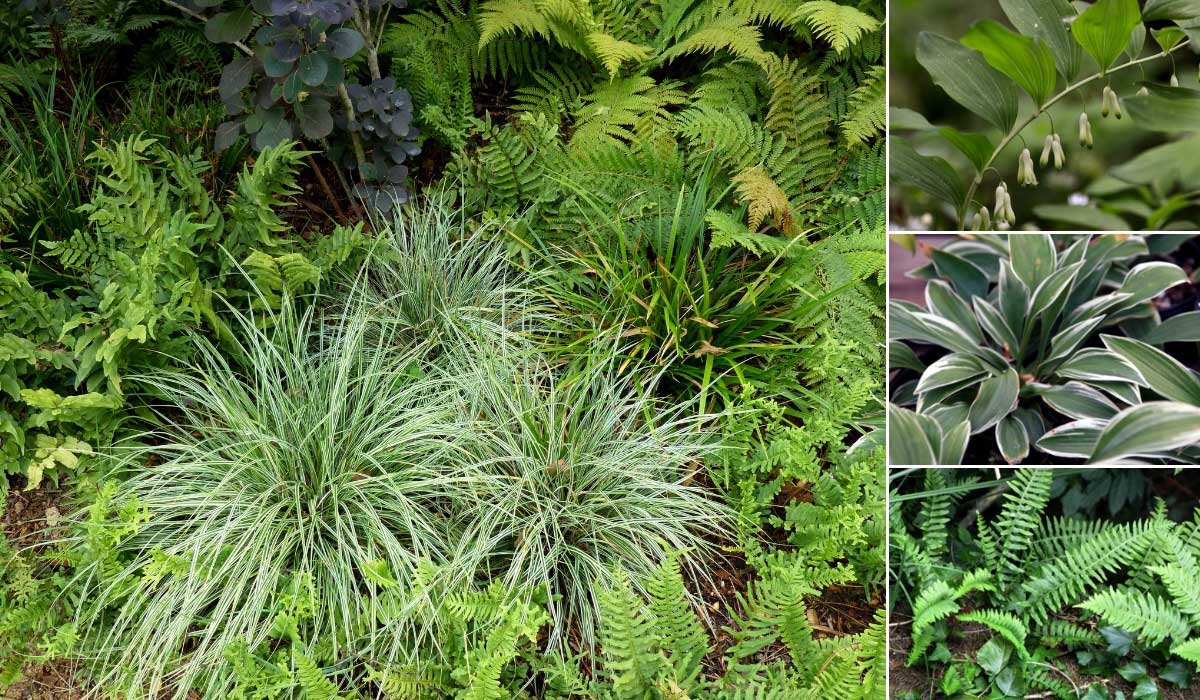
Carex pair perfectly with the foliage of ferns, creating a very natural scene! Carex ‘Everest’, Polypodium vulgare ‘Bifido-Multifidum’ and Cyrtomium fortunei / Polygonatum multiflorum (photo Radio Tonreg) / Hosta ‘Allan P. McConnell’ (photo David J. Stang) / Polypodium vulgare (photo Lamiot)
Because they prefer cool, even moist soils, carex can be planted at the edge of a pond. We recommend the species Carex acuta or Carex riparia, which are particularly suitable and will also help to stabilise the banks. They will thrive alongside reeds, Iris pseudacorus, Asian primroses, Menyanthes trifoliata, reeds, and papyrus (choose Cyperus alternifolius for its hardiness)… This will create a stunning, quite wild and natural scene, ideal for recharging your batteries!
As they form small, sometimes quite compact clumps, carex can be planted in pots with Muehlenbeckia, heucheras, and some flowers, such as bellflowers, bidens, or lobelia… You can then place them on a windowsill, balcony, or terrace!
Some varieties of carex have the advantage of bringing an exotic look to the garden! Those with bronze or copper foliage can be integrated into a bed of southern plants, alongside phormiums, agapanthuses, cordylines… Add some agaves, kniphofias, and crocosmias. The Carex ciliatomarginata ‘Shima Nishiki’, whose foliage resembles that of bamboos, can find its place in a Japanese-style garden, alongside real bamboos, ferns (for example Athyrium niponicum), Acer palmatum, Hakonechloa macra, and azaleas.
→ Discover 5 beautiful ideas for combining carex in Jean-Christophe’s advice sheet!
Did you know?
- Various uses!
Thanks to their long leaves, which are both fine and sturdy, carex are used in Japan to make farmers’ hats. They can also be used for reupholstering the layer of chairs, as well as in basketry. Since they are well adapted to wet mediums, carex are also useful for stabilising riverbanks and for phytoremediation. They can be employed in ecological restoration projects for landscapes and natural habitats.
Useful resources
-
- Discover our wide range of Carex!
- Our advice sheets:
- How to grow and maintain Carex in pots,
- 5 Carex to grow in pots,
- 6 Carex with variegated foliage,
- 6 Carex for shade
- How to propagate Carex? We provide all our tips.
- An article by Michael on our blog – Carex testacea Lime Shine: a very bright sedge to discover!
- Our advice sheet – Grasses: Which variety to choose?
- An article by Michael – Grasses: those that are pruned, those that are trimmed
- To learn everything and make the right choice, check out our buying guide dedicated to Carex
- Learn more about grasses for a garden exposed to the north
Frequently asked questions
-
Should I prune the carex at the end of winter?
Unlike deciduous grasses, which should be cut back to the ground in winter, carex should be left as they are! You can simply comb through the clumps to remove dead leaves.
- Subscribe!
- Contents
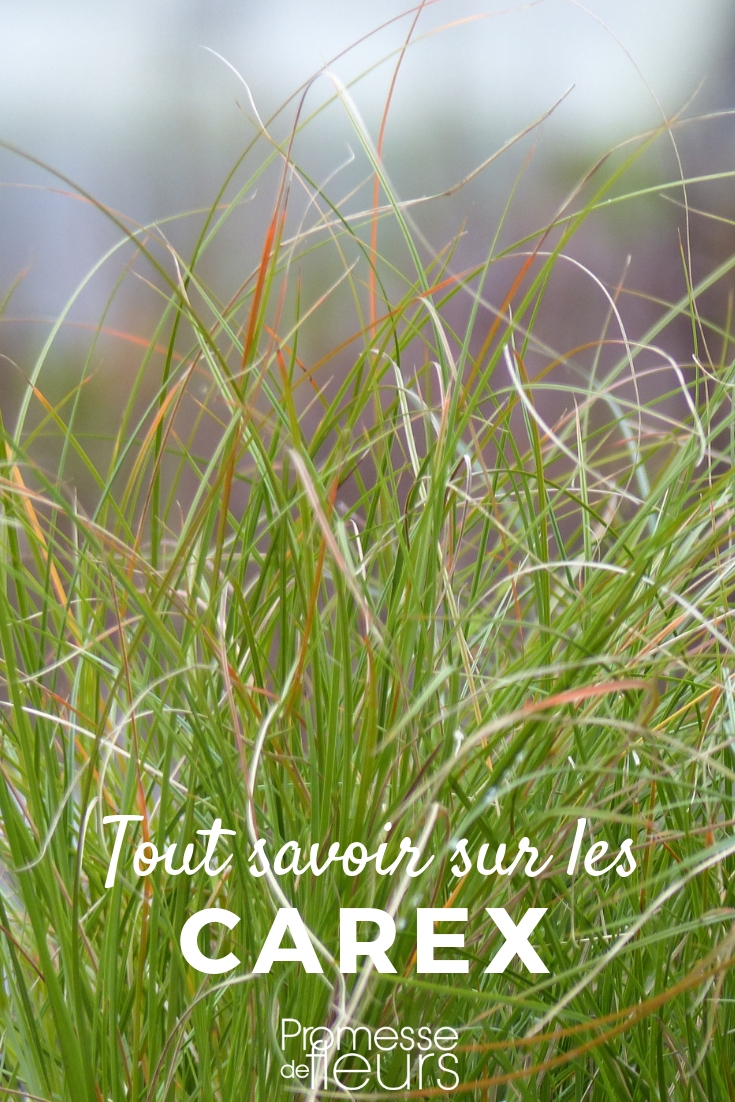































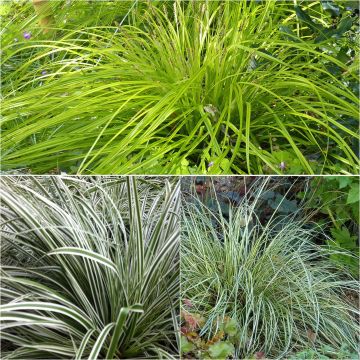
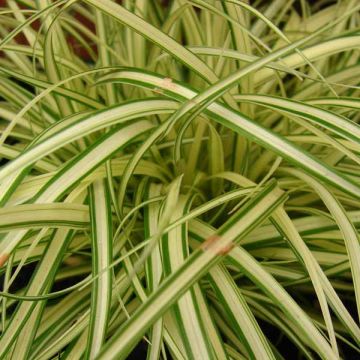
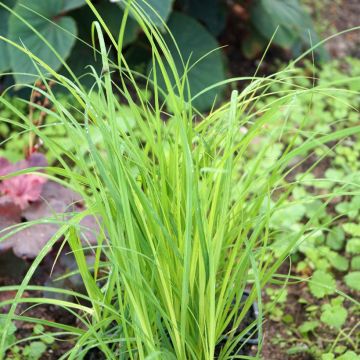

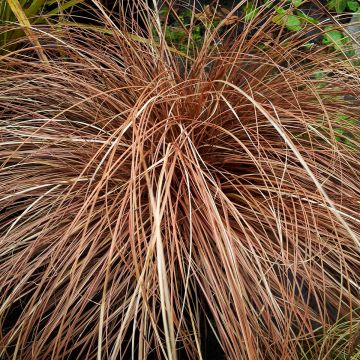
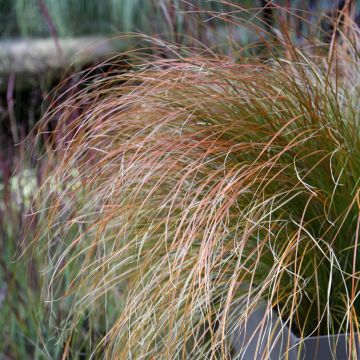

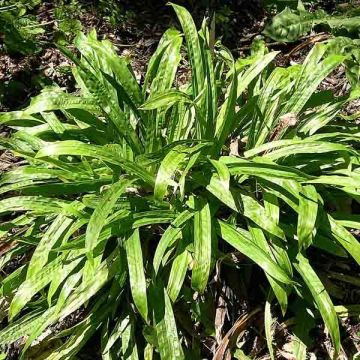

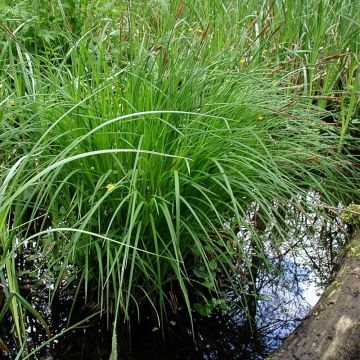
Comments